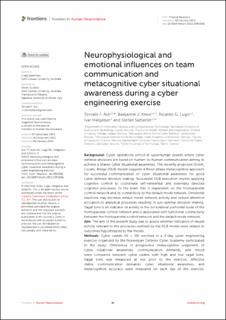Neurophysiological and Emotional Influences on Team Communication and Metacognitive Cyber Situational Awareness During a Cyber Engineering Exercise
Ask, Torvald Fossåen; Knox, Benjamin James; Lugo, Ricardo Gregorio; Helgetun, Ivar; Sütterlin, Stefan
Peer reviewed, Journal article
Published version
Permanent lenke
https://hdl.handle.net/11250/3051888Utgivelsesdato
2023Metadata
Vis full innførselSamlinger
Originalversjon
Frontiers in Human Neuroscience. 2023, 16, Artikkel 1092056. 10.3389/fnhum.2022.1092056Sammendrag
Background: Cyber operations unfold at superhuman speeds where cyber defense decisions are based on human-to-human communication aiming to achieve a shared cyber situational awareness. The recently proposed Orient, Locate, Bridge (OLB) model suggests a three-phase metacognitive approach for successful communication of cyber situational awareness for good cyber defense decision-making. Successful OLB execution implies applying cognitive control to coordinate self-referential and externally directed cognitive processes. In the brain, this is dependent on the frontoparietal control network and its connectivity to the default mode network. Emotional reactions may increase default mode network activity and reduce attention allocation to analytical processes resulting in sub-optimal decision-making. Vagal tone is an indicator of activity in the dorsolateral prefrontal node of the frontoparietal control network and is associated with functional connectivity between the frontoparietal control network and the default mode network. Aim: The aim of the present study was to assess whether indicators of neural activity relevant to the processes outlined by the OLB model were related to outcomes hypothesized by the model. Methods: Cyber cadets (N = 36) enrolled in a 3-day cyber engineering exercise organized by the Norwegian Defense Cyber Academy participated in the study. Differences in prospective metacognitive judgments of cyber situational awareness, communication demands, and mood were compared between cyber cadets with high and low vagal tone. Vagal tone was measured at rest prior to the exercise. Affective states, communication demands, cyber situational awareness, and metacognitive accuracy were measured on each day of the exercise. Results: We found that cyber cadets with higher vagal tone had better metacognitive judgments of cyber situational awareness, imposed fewer communication demands on their teams, and had more neutral moods compared to cyber cadets with lower vagal tone. Conclusion: These findings provide neuroergonomic support for the OLB model and suggest that it may be useful in education and training. Future studies should assess the effect of OLB-ing as an intervention on communication and performance.
Utgiver
Frontiers Media S.A.Tidsskrift
Frontiers in Human NeuroscienceOpphavsrett
© 2023 Ask, Knox, Lugo, Helgetun and Sütterlin.Beslektede innførsler
Viser innførsler beslektet ved tittel, forfatter og emneord.
-
Cyber-Physical Power System (CPPS): A Review on Modelling, Simulation, and Analysis with Cyber Security Applications
Yohanandhan, Rajaa Vikhram; Elavarasan, Rajvikram Madurai; Manoharan, Premkumar; Mihet-Popa, Lucian (Peer reviewed; Journal article, 2020)Cyber-Physical System (CPS) is a new kind of digital technology that increases its attention across academia, government, and industry sectors and covers a wide range of applications like agriculture, energy, medical, ... -
A 3D mixed reality visualization of network topology and activity results in better dyadic cyber team communication and cyber situational awareness
Ask, Torvald Fossåen; Kullman, Kaur; Sütterlin, Stefan; Knox, Benjamin James; Engel, Don; Lugo, Ricardo Gregorio (Peer reviewed; Journal article, 2023)Background: Cyber defense decision-making during cyber threat situations is based on human-to-human communication aiming to establish a shared cyber situational awareness. Previous studies suggested that communication ... -
Self-regulation and cognitive agility in cyber operations
Jøsok, Øyvind; Lugo, Ricardo Gregorio; Knox, Benjamin James; Sütterlin, Stefan; Helkala, Kirsi Marjaana (Journal article; Peer reviewed, 2019)

